Dive into the rich history of gardens in ancient Egypt, from opulent royal estates to humble household plots. Uncover the array of plants, intricate designs, and profound symbolism tied to Egyptian gardens, featuring sacred flora like the lotus and sycamore fig, which embodied spirituality, renewal, and divine connection. These green havens mirrored Egypt's deep respect for nature, blending practical use with religious significance.

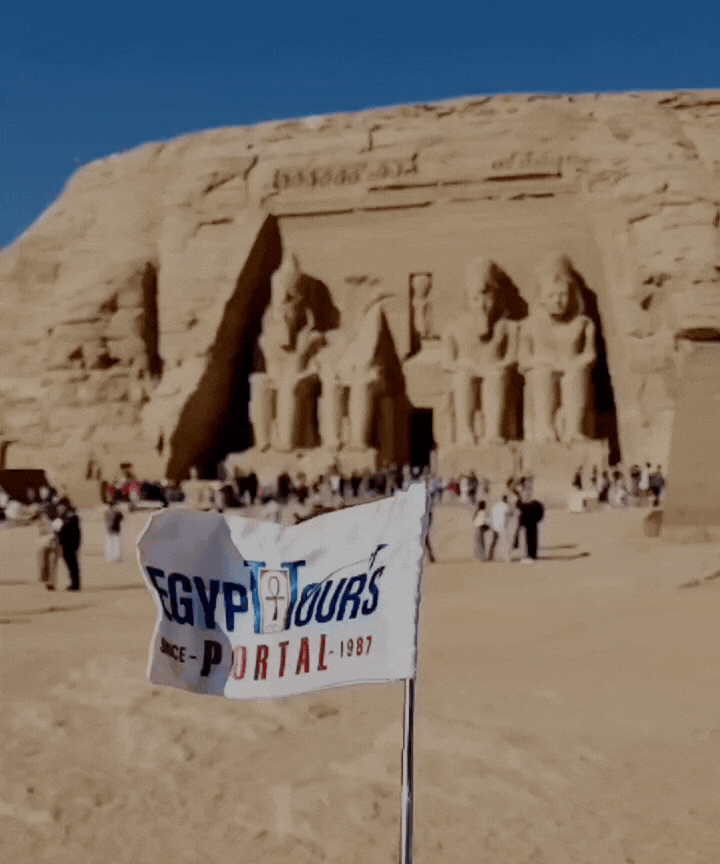
Ancient Egyptian gardens were essential to daily life, religion, and the afterlife, offering sustenance and symbolic meaning. Located along the Nile, these gardens ranged from royal estates to practical plots for commoners, reflecting Egypt’s reverence for nature and its divine connections.
Plants like the sacred lotus and sycamore fig held deep cultural and spiritual significance. Everyone will explore the design, plant life, and evolving role of gardens in ancient Egypt, highlighting their function as both aesthetic spaces and representations of spiritual renewal.
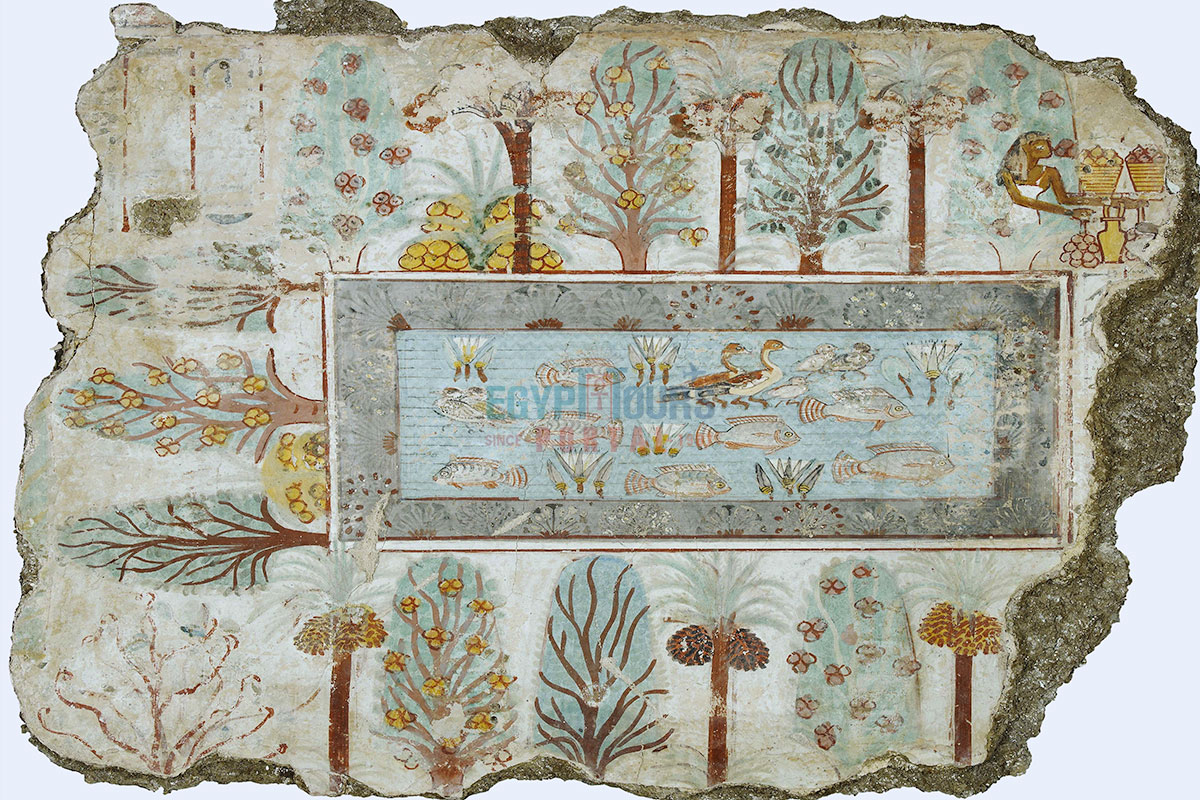
Gardens were integral to daily life in ancient Egypt, providing not just beauty and leisure but essential resources for food, medicine, and religious offerings. The Old Kingdom (c. 2686–2181 BCE) marks the earliest development of gardens as functional spaces for growing crops. Fruits such as dates, figs, and pomegranates were common, while vegetables like onions, leeks, and cucumbers were regularly cultivated.
In addition to food, gardens provided raw materials for medicinal remedies (e.g., coriander, cumin, and fennel) and everyday items like baskets, mats, and rope. These plants were not only used in homes but also for ceremonial purposes. For example, barley was used in religious offerings, while grapevines were crucial for winemaking. The use of lotus flowers and papyrus in funerary contexts is also well documented in ancient tombs, showing the multi-purpose nature of gardens.

Egyptian gardens were profoundly connected to religious practices, where plants symbolized the gods of ancient Egypt and the afterlife. The New Kingdom (c. 1550–1070 BCE) saw the height of garden symbolism, particularly in temple gardens. The lotus (Nymphaea caerulea) was linked to the sun god Re and represented the cycle of creation and rebirth.
The sycamore fig (Ficus sycomorus) was sacred to Hathor, the goddess of fertility and motherhood. Other plants, like the pomegranate (Punica granatum), were considered symbolic of eternal life. In temple complexes, gardens featured trees that were aligned with deities. The Temple of Karnak, for example, boasted extensive gardens of figs, palm trees, and tamarisks, used both for ceremonial offerings and as a metaphor for the divine nourishment that sustained life.
Explore more magnificent details about the rituals, beliefs, and customs of the religion of the ancient Egyptians.
Read More
The design of ancient Egyptian gardens was rooted in symmetry and order, reflecting the Egyptians’ reverence for balance and harmony. Walls and enclosures were commonly used to protect the garden from animals and keep the space private. The gardens were typically rectangular or square in shape, designed with a clear grid pattern. Water features, especially ponds or canals, were central to Egyptian gardens, allowing for irrigation and enhancing the visual aesthetic of the space.
The New Kingdom period (c. 1550–1070 BCE) saw more sophisticated gardens with water management systems, as well as ornamental ponds decorated with lotus flowers and papyrus. These features also had practical uses—shadufs, simple water-lifting devices, were developed during this period to transport water from the Nile River for irrigation.
The types of plants selected for Egyptian gardens were carefully chosen based on their utility, symbolism, and beauty. Sycamore fig trees, date palms, pomegranates, and lotus flowers were common, with the plants arranged to create a pleasing symmetry. During the Middle Kingdom (c. 2050–1710 BCE), gardens began to show greater complexity, with plants like carob trees, tamarisks, and willows being used.
Herbs such as mint, coriander, and cumin were strategically planted for medicinal and culinary purposes. Papyrus and blue lotus were frequently used to decorate ponds and add color to water features. The Mandrake (Mandragora officinarum), used for its hallucinogenic properties, was another plant that reflected the Egyptians' connection to the mystical aspects of nature.

The ancient Egyptians imbued many plants with symbolic meanings, which were intimately tied to their religious and cultural beliefs. The lotus flower, revered in both Upper and Lower Egypt, represented the sun and rebirth. It was said that Re, the sun god, emerged from a lotus in the primeval waters at the dawn of creation. Similarly, the date palm, associated with Re and often depicted in royal iconography, symbolized life, nourishment, and fertility.
The sycamore fig, another sacred tree, was linked to Hathor, the goddess of love, music, and fertility. These plants were more than just decorative; they had deep religious and symbolic connections that tied them to the gods and the cycle of life and death.
Specific plants were also associated with certain gods and myths. The sycamore fig tree, for example, was not only symbolic of fertility but also had links to Hathor, who was often depicted as a tree goddess. The pomegranate, which was introduced during the New Kingdom, was also a symbol of fertility and rebirth.
The papyrus, another plant found near the Nile, symbolized the unity of Lower Egypt and was sacred to Thoth, the god of wisdom and writing. These symbolic associations made plants integral to religious rituals and the afterlife.
Explore enchanting facts and details about the ancient Egyptian Symbols.
Read More
Water management was crucial for sustaining gardens in a country where rainfall was scarce. The Nile River provided the lifeblood for Egyptian agriculture, but gardens often had to be located on higher ground, away from the floodplain. The ancient Egyptians developed sophisticated techniques to manage irrigation.
One of the most important inventions was the shaduf, a hand-operated device used to lift water from the Nile and canals to irrigate gardens. This device was in use from at least the New Kingdom period (c. 1550–1070 BCE). For wealthier Egyptians, wells were dug closer to their homes to ensure easier access to water. This innovation in water management allowed gardens to thrive even in Egypt's arid climate.
The cultivation of plants in Egypt was based on the annual flooding of the Nile, which fertilized the soil with rich silt. The Old Kingdom (c. 2686–2181 BCE) saw the earliest large-scale irrigation systems, which were refined during the Middle and New Kingdoms.
The cultivation of food crops such as barley, wheat, and lentils was aligned with the seasons, and gardens would be flooded after the Nile's annual inundation. Fruit trees like figs, dates, and pomegranates were carefully nurtured, while papyrus and lotus flowers were used to adorn garden ponds. Seasonal flooding allowed for two planting cycles per year, ensuring a year-round harvest.
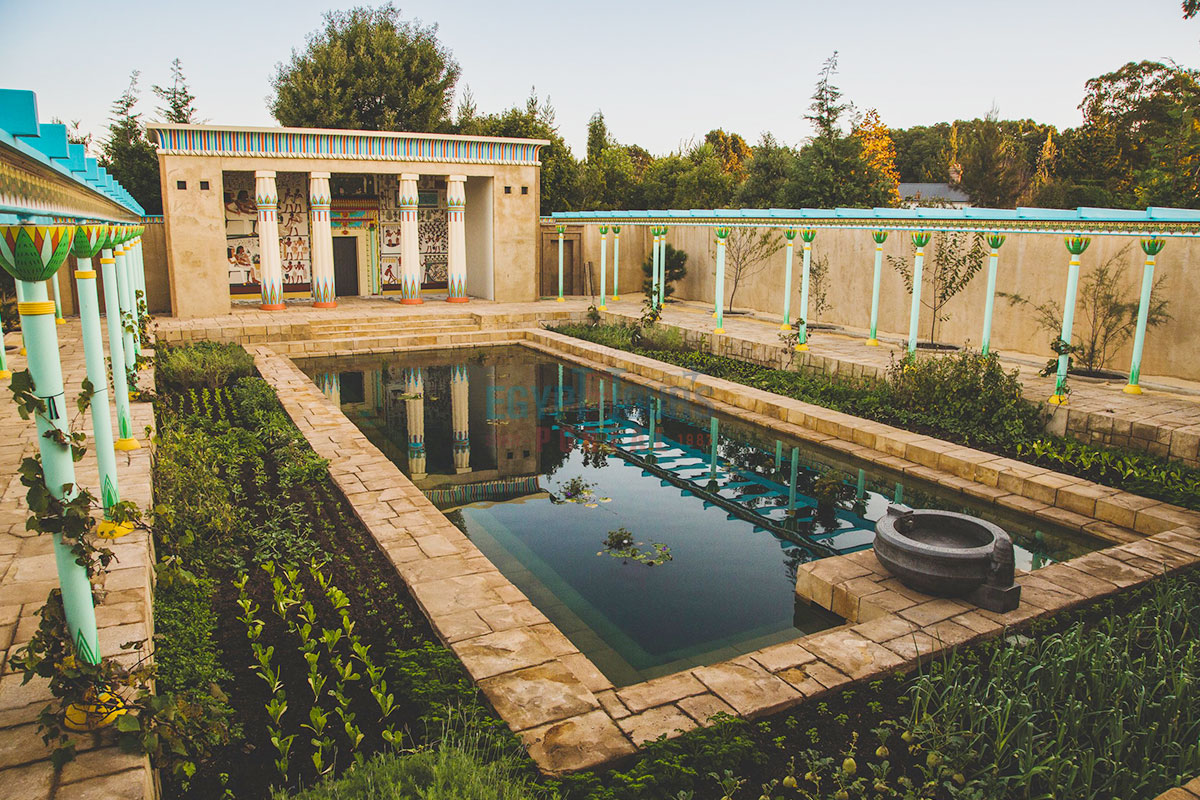
The grand gardens of Egyptian pharaohs and nobility served not only as recreational spaces but as symbols of power and wealth. Royal gardens, like those of Queen Hatshepsut (c. 1503–1482 BCE), were meticulously designed and included exotic plants brought from foreign lands, such as frankincense trees from Punt (modern-day Somalia or Ethiopia).
The Middle Kingdom (c. 2040–1782 BCE) saw the creation of gardens for royal residences and temples, which featured grand water ponds, rows of trees, and elaborate flower beds. These gardens were often designed with geometric precision, symbolizing the king’s power over nature. Exotic plants, including those imported from Asia during the Ptolemaic period (305–30 BCE), further highlighted the grandeur of royal gardens.
For common Egyptians, gardens were smaller, more functional, and focused on practical uses. These gardens typically included vegetables, fruits, and herbs essential for daily living. Onions, leeks, and garlic were staples, while lentils and wheat were cultivated for food. The designs of common gardens were simpler, often consisting of small enclosed spaces with basic water features. These gardens, though less elaborate, provided essential sustenance and were part of everyday life in ancient Egypt.
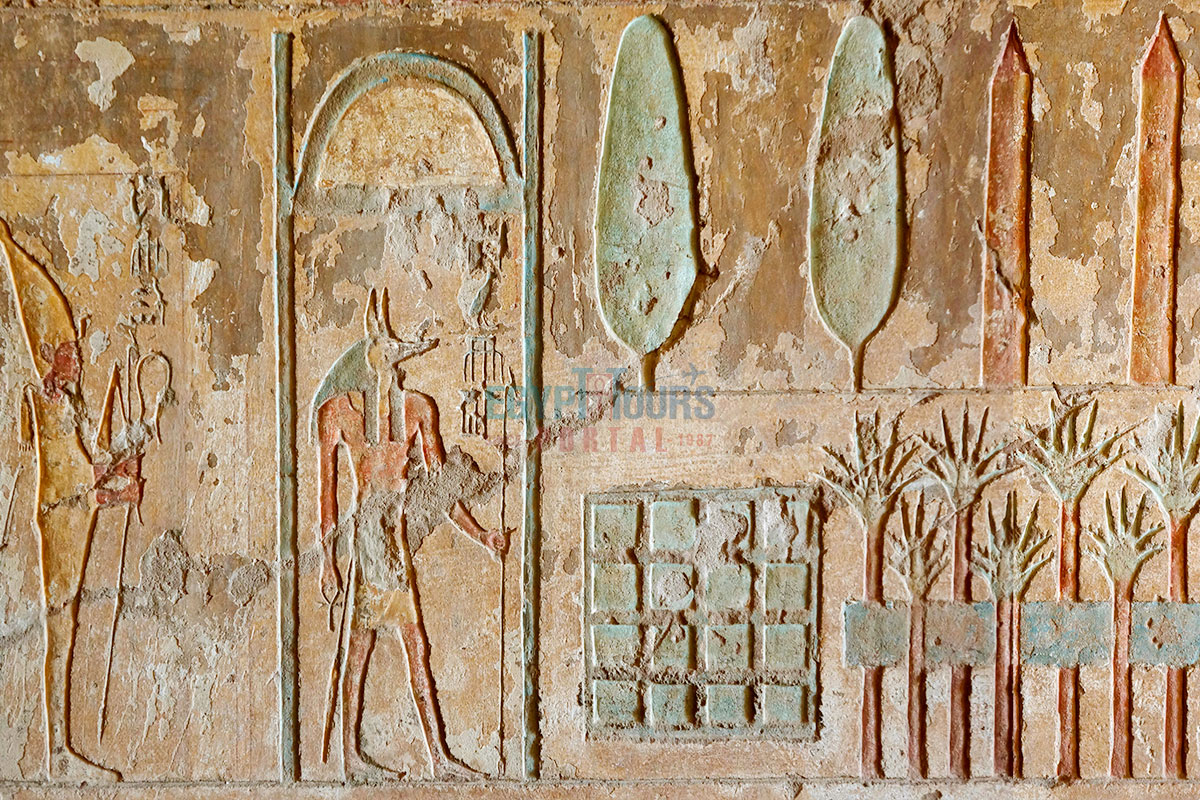
Gardens held profound cultural significance in ancient Egypt, as evidenced by their depiction in tomb art and funerary models. Tomb paintings from the 18th Dynasty (c. 1550–1295 BCE) depict lush gardens filled with trees, flowers, and water features. The famous tomb of Nebamun, for instance, showcases a vibrant garden with a pond teeming with wildlife and surrounded by fruit-bearing trees such as figs and sycamore figs.
These depictions represent the idealized, paradisiacal gardens where the deceased would live eternally. Wooden models of gardens, like those found in the tomb of Meketre (c. 1985–1773 BCE), also provide a glimpse into the design of ancient Egyptian gardens. These models often included ponds, trees, and flowers, serving as representations of the deceased's eternal life.
In ancient Egyptian art, gardens were often depicted as spaces of divine beauty and abundance, symbolizing the fertility and rejuvenation of life. These gardens, especially in tombs, were portrayed as places where the deceased could enjoy the pleasures of nature forever. The recurring motifs of trees, water lilies, and palm trees in tomb art reflect the importance of these spaces as powerful ancient Egyptian symbols of eternal life, nourishment, and rebirth.
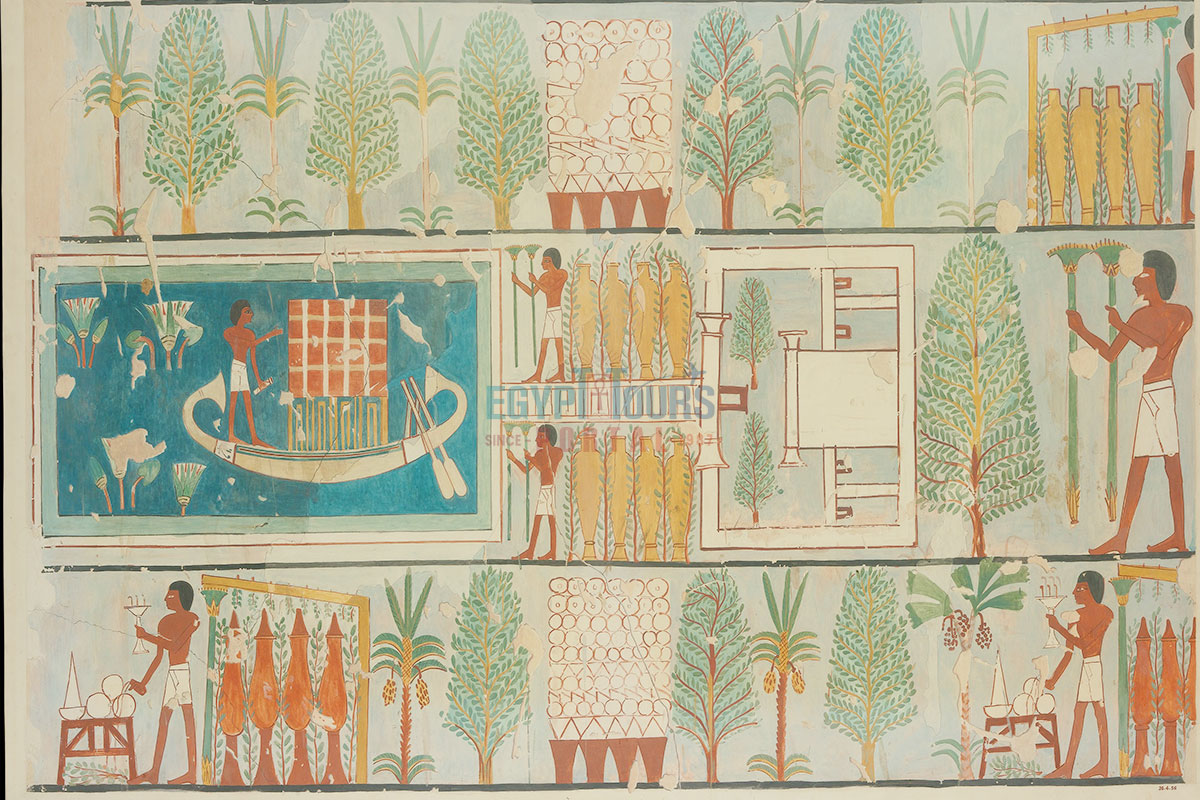
The design and function of gardens evolved significantly throughout Egyptian history. During the Old Kingdom (c. 2686–2181 BCE), gardens were mainly functional, serving the needs of the elite and religious institutions. By the New Kingdom (c. 1550–1070 BCE), gardens became more decorative, reflecting the growing wealth and influence of the pharaohs. Ptolemaic gardens (305–30 BCE) saw the introduction of exotic plants and advanced irrigation techniques, with gardens becoming even more elaborate, particularly in Alexandria and other royal centers.
Cultural exchange with neighboring civilizations, including the Greeks and Persians, led to the introduction of new plants like the pomegranate, olive, and almond trees. These influences also brought new gardening techniques, such as more sophisticated irrigation methods and the cultivation of ornamental plants.
The impact of foreign cultures was particularly evident during the Ptolemaic period, when Alexandria became a hub for the exchange of botanical knowledge, contributing to the rich diversity of plants in Egyptian gardens.
Gardens in ancient Egypt were multifaceted spaces that played a vital role in Egyptian life, culture, and religion. Whether serving as places of sustenance, symbolizing the afterlife, or showcasing the wealth of the elite, these gardens were deeply intertwined with the spiritual and social fabric of Egyptian civilization.
The meticulous design, diverse plant selection, and symbolic meanings of plants in gardens are testaments to the advanced horticultural practices of the ancient Egyptians and their profound understanding of nature’s role in both life and death. The miraculous beauty radiates from every plant and garden, so book your favorite one of our majestic Egypt vacation Packages or Nile River Cruises and cast your eyes on all the heavenly treasures of this immortal civilization.
Private 4 Days Cairo Tour Packages for New Zealander Travelers 4 days Cairo Egypt To...
Tour Location: Cairo – Giza...
5 Days Cairo and Alexandria Tour Package For New Zealander Travelers 5 days Cairo an...
Tour Location: Cairo/Giza/Alexandria...
6 Days Cairo, Luxor & Aswan Tour Package For New Zealander Travelers 6 days Cair...
Tour Location: Cairo/Giza/Aswan/Luxor...
Amazing 7 Days Cairo and Hurghada Holiday for New Zealander Travelers 7 Days Cairo &...
Tour Location: Cairo – Giza – Hurgh...
Gardens served multiple purposes, including providing food, medicinal plants, and materials for daily use, as well as functioning as spaces for religious rituals and aesthetic enjoyment.
Common plants included sycamore figs, date palms, papyrus, lotus flowers, grapevines, and vegetables such as onions, garlic, and lettuce.
Many plants have religious and cultural symbolism. For example, the lotus represented creation and rebirth, the papyrus symbolized Lower Egypt, and the sycamore tree was associated with the goddess Hathor.
Gardens often had symmetrical layouts, enclosed walls for protection and privacy, and central water features such as ponds or canals surrounded by rows of plants.
Irrigation relied on water from the Nile, raised using tools like the shaduf, and distributed through canals and ditches to ensure consistent watering.
Yes, elaborate gardens with exotic plants and large water features were symbols of wealth and power, often associated with royalty and the elite.
Sacred gardens were often part of temple complexes, with plants used for offerings and rituals. Certain trees and flowers, like the lotus, had direct connections to gods and myths.
Gardens appear in tomb paintings and models, often depicted as lush, idealized spaces with symmetrical rows of trees, and ponds filled with fish, and flowering plants.
The lotus and papyrus were among the most significant flowers, symbolizing life, rebirth, and the unification of Upper and Lower Egypt.
Commoners grew small household gardens to cultivate fruits, vegetables, and herbs for food and medicine, focusing on practical needs.
Yes, exotic plants like incense trees and other species were imported from neighboring regions, particularly for royal and temple gardens.
Egyptians used tools like hoes, sickles, and shadufs for planting, maintaining, and irrigating their gardens.
Ponds and canals were central to garden design, serving practical irrigation purposes and adding aesthetic and symbolic value, often stocked with fish and adorned with lotuses.
Gardens were depicted in tombs as paradisiacal spaces, symbolizing eternal life and abundance in the afterlife, with idealized depictions of lush greenery and flowing water.
The design and symbolism of Egyptian gardens influenced other ancient civilizations, including Greek and Roman horticultural traditions.
The entire country of Egypt deserve to be explored with its every heavenly detail but there are places that must be seen before any other such as the breathtaking Hurghada's red sea, The wonders of Cairo the pyramids of Giza, the great sphinx, the Egyptian Museum, Khan El Khalili Bazaar, the wonders of Luxor like Valley of the Kings, Karnak & Hatshepsut temple and the wonders of Aswan such as Abu Simbel temples, Philea temple, Unfinished obelisk and The Wonders of Alexandria like Qaitbat Citadel, Pompey's Pillar and Alexandria Library. Read more about the best places to visit in Egypt.
If you want to apply for a Visa On Arrival that lasts for 30 days then you should be one of the eligible countries, have a valid passport with at least 6 months remaining and pay 25$ USD in cash, as for the E-Visa for 30 day you should have a valid passport for at least 8 months, complete the online application, pay the e-visa fee then print the e-visa to later be presented to the airport border guard. You could also be one of the lucky ones who can obtain a free visa for 90 days. Read more about Egypt travel visa.
Egypt has a variety of delicious cuisines but we recommend “Ful & Ta’meya (Fava Beans and Falafel)”, Mulukhiya, “Koshary”, a traditional Egyptian pasta dish, and Kebab & Kofta, the Egyptian traditional meat dish.
The best time to travel to Egypt is during the winter from September to April as the climate becomes a little tropical accompanied by a magical atmosphere of warm weather with a winter breeze. You will be notified in the week of your trip if the Climate is unsafe and if any changes have been made.
You should pack everything you could ever need in a small bag so you could move easily between your destinations.
We have been creating the finest vacations for more than 20 years around the most majestic destinations in Egypt. Our staff consists of the best operators, guides and drivers who dedicate all of their time & effort to make you have the perfect vacation. All of our tours are customized by Travel, Financial & Time consultants to fit your every possible need during your vacation. It doesn't go without saying that your safety and comfort are our main priority and all of our resources will be directed to provide the finest atmosphere until you return home.
You will feel safe in Egypt as the current atmosphere of the country is quite peaceful after the government took powerful measures like restructuring the entire tourist police to include all the important and tourist attractions in Egypt. Read more about is it safe to travel to Egypt.
Wear whatever feels right and comfortable. It is advised to wear something light and comfortable footwear like a closed-toe shoe to sustain the terrain of Egypt. Put on sun block during your time in Egypt in the summer to protect yourself from the sun.
The best activity is by far boarding a Nile Cruise between Luxor and Aswan or Vise Versa. Witness the beauty of Egypt from a hot balloon or a plane and try all the delicious Egyptian cuisines and drinks plus shopping in old Cairo. Explore the allure and wonders of the red sea in the magical city resorts of Egypt like Hurghada and many more by diving and snorkeling in the marine life or Hurghada. Behold the mesmerizing western desert by a safari trip under the heavenly Egyptian skies.
There are a lot of public holidays in Egypt too many to count either religious or nation, the most important festivals are the holy month of Ramadan which ends with Eid Al Fitr, Christmas and new years eve. Read more about festivals & publich holidays in Egypt.
Egypt is considered to be one of the most liberal Islamic countries but it has become a little bit conservative in the last couple of decades so it is advised to avoid showing your chest, shoulders or legs below the knees.
Arabic is the official language and Most Egyptians, who live in the cities, speak or understand English or at least some English words or phrases. Fewer Egyptians can speak French, Italian, Spanish, and German. Professional tour guides, who work in the tourism sector, are equipped to handle visitors who cannot speak Arabic and they will speak enough English and other languages to fulfill the needs of all our clients.
The fastest way is a car, of course, a taxi. If you are in Cairo ride a white taxi to move faster or you could board the fastest way of transportation in Egypt metro if the roads are in rush hour.
The temperature in Egypt ranges from 37c to 14 c. Summer in Egypt is somehow hot but sometimes it becomes cold at night and winter is cool and mild. The average of low temperatures vary from 9.5 °C in the wintertime to 23 °C in the summertime and the average high temperatures vary from 17 °C in the wintertime to 32 °C in the summertime. The temperature is moderate all along the coasts.
It is the home of everything a traveler might be looking for from amazing historical sites dating to more than 4000 years to enchanting city resorts & beaches. You will live the vacation you deserve as Egypt has everything you could possibly imagine.









